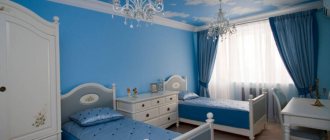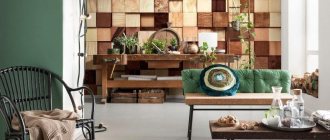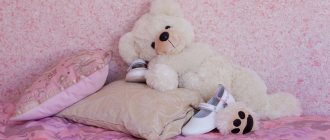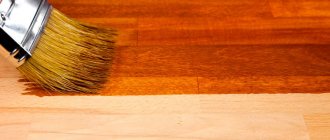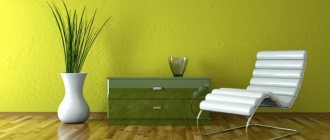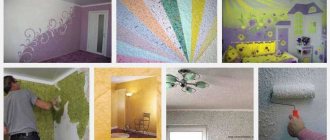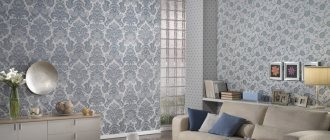Before buying or gluing silk liquid wallpaper, It is necessary to become familiar with their advantages, disadvantages and application methods. The product is a completely environmentally friendly material made from natural ingredients. The main elements are: cotton, silk, cellulose and decorative additives in the form of sparkles and beads.
Sand and cement are not added to this type. And thanks to the wide range of colors, the possibility of combination with any interior is taken into account.
Types and characteristics
There are two types, each of them has its own characteristics.
Textile
A more common and familiar look. They consist of two layers - paper and a layer of viscose with the addition of cellulose and natural silk fibers. Very durable, do not fade in the sun and are an environmentally friendly material. They look like silk fabric. They can be plain or with a pattern. They are distinguished by a rather high price, but pay for themselves during operation.
Liquid
A mixture that is diluted with water and applied to walls or ceilings using a spatula or roller, resulting in a seamless coating. They contain only natural silk components. Resistant to mold, mildew and temperature changes.
The photo shows a room with a wall decorated with liquid silk wallpaper.
Decorative plaster wet silk
Unlike liquid wallpaper, wet silk decorative plaster most often does not contain any silk thread. However, there are exceptions; natural silky fibers are sometimes added to expensive types of plasters in order to achieve the maximum silk effect. The basis of the plaster is acrylic water dispersion, additives, fine quartz sand, and pigment with mother-of-pearl.
Applying a decorative solution gives a wet silk effect, thanks to various additives. These are the main texture components, the presence and quantity of which each manufacturer keeps secret. Therefore, textured silk plaster is very different from various brands. Decorative plaster is produced in the form of a thick paste of five main colors: silver, pearl, white, gold, garnet red.
Textured material with a wet effect is applied in very thin layers, so surface preparation must be done very carefully. The wall must be made with your own hands completely flat and smooth by any available means so that the application of the main coating is of high quality. Finishing work can only be done on dry walls and ceilings as follows:
- A primer is applied to the leveled surface of the wall and ceiling.
- Pigment is added to the finished solution to achieve the desired shade of imitation silk effect, mixing the paste manually or with a mixer, but at the lowest speed. Increasing the speed may cause the silk fibers to break if they are added to the paste.
- It is advisable to apply the first layer with a velor roller so that it turns out very thin and of uniform thickness.
- The next layer of wet mixture is applied to the wall with a spatula, moving your hand in different directions. Movements can repeat an arc, a circle, a figure eight, a wave, and all kinds of curls. This will help create an interesting silk effect.
- The final smoothing of the plaster with your own hands is done with a trowel, making continuous horizontal and vertical strokes, from one corner of the room to the other.
Article on the topic: Cross stitch of landscapes of large sizes: patterns for free, sea and winter, urban and rural, small monochrome, sets for autumn, summer and spring
In the case of interior decoration using decorative plaster with a wet effect, much depends on the composition of the mixture, but even more on the imagination and skill of the performer.
Advantages and disadvantages
Like all other types of wallpaper, silk has its advantages and disadvantages.
| Advantages | Flaws |
| Textile fabrics are hypoallergenic and do not emit harmful substances. | They are afraid of moisture, dust, absorb odors, and are not recommended for use in the bathroom and kitchen. |
| They have an elite appearance, original design and a huge variety of colors. | Quite a high price. |
| Silk liquid wallpaper requires little cost and consumables. Easy to apply and form a perfectly even coating. | The operating time exceeds the time for gluing conventional wallpaper. |
| They do not attract dust. Antistatic, fireproof. Eco-friendly and do not cause allergies. |
Liquid wallpaper in the hallway/corridor
If you want your apartment to make an impression right away, at the threshold, use liquid wallpaper with noticeable fiber particles and a fairly large stone fraction. Such a catchy, textured finish will impress any guest. But remember that during the off-season and bad weather, umbrellas, raincoats and wet shoes accumulate in the hallway. And liquid wallpaper, as mentioned above, is sensitive to moisture.
Advice . After complete drying, it is better to coat Danish plaster with acrylic varnish, which will increase its durability. And if you don't like the color, the trim can be repainted.
Also think carefully about how the walls will look under artificial lighting. In the hallway, most often, there is little sun, and the texture of liquid wallpaper is so diverse that it can both absorb artificial light and scatter it.
Photo ideas in the interior of rooms
An original design option, they look very interesting on the walls and will become a real highlight in any room.
In the kitchen
For kitchens, it is more appropriate to use liquid finishing materials in natural colors: peach or beige. They create a perfectly smooth and thin coating with a slight satin shimmer that visually enlarges the room. This makes them a real boon for small kitchens.
The photo shows the interior of a kitchen decorated with textile wallpaper made of golden silk.
In the living room
Calmer beige, sand, olive or soft pink colors will look good. If desired, you can apply a design in the form of royal lilies or monograms with gold, silver or burgundy paint. Decorations with moldings, baguettes or stucco are ideal for plain wallpaper.
The photo shows a living room with silk textile wallpaper on the walls.
In the bedroom
This decoration will add aristocratic elegance and sophistication to the bedroom design. By decorating a room with this material, it feels as if the walls are covered with silk fabric. Due to this, the interior turns out to be quite cozy.
The photo shows a bedroom with patterned turquoise walls.
Liquid wallpaper application technology
How to apply liquid wallpaper? Experts have developed several methods for applying the working composition to a vertical and horizontal plane. They include:
- To finish the ceiling, use a flat spatula. A small amount of the working composition is applied to it. Next, the decorations are evenly distributed in a circular motion. The surface is first carefully treated to remove external defects and primed;
- For finishing the kitchen, we recommend purchasing an additional supply of consumables. The corner parts of the space are treated with the working composition. Movements are carried out from bottom to top;
- To treat plasterboard structures, the entire frame is puttied with a finishing mixture. After this, it can be coated with acrylic paint.
Colors
Color selection is of primary importance when creating an interior.
White
They increase the space and add a touch of freshness and cleanliness. White has excellent compatibility with all colors. In order to get rid of the excessive sterility of this color, it is enough to add a few bright accents.
The photo shows the interior of the living room and the walls lined with silk wallpaper.
Black
They are distinguished by unsurpassed graphics. Black sets contrast, enhances, emphasizes and creates an edging for other shades in the interior. This color can be used not only as a background, but also to delimit space.
The photo shows a modern-style bedroom with black silk wallpaper on the walls.
Beige
Beige is great for creating calm interiors, in which all attention is switched not to color, but to texture. Therefore, you need to very carefully select textured surfaces and their combination with each other.
Greens
They refresh and soothe, allowing you to safely experiment with decoration. Pairs best with yellow, brown and blue.
The photo shows a bedroom decorated with green silk wallpaper.
Reds
They will allow you to create a rich, elite interior. In combination, it is better to give preference to black and gold.
Liquid wallpaper consumption
What is the price and consumption of liquid wallpaper per square meter? Experts recommend spending an average of 1 sq.m. 0.5 kg of dry composition. The purchase price directly depends on the area of the room and the presence of external effects.
For an even surface you will need from 0.3 to 0.5 kg. It is also necessary to take into account the inclination and movements of the spatula during the application of the working composition to the walls. For example, if you hold a construction spatula at an angle of 45 degrees, then approximately 0.2 kg will be consumed during application.
Design examples
When decorating a room, the main goal is to make the interior authentic and fashionable.
With golden threads
They attract all attention, attract and enchant. Gold threads will add luxury to the interior. They will be appropriate even in a minimalist style. You can complement the unique image with the help of small lamps or candlesticks.
In the photo there is a room decorated with silk wallpaper with gold threads.
With the birds
Birds are a symbol of lightness and freedom; their presence in drawings creates a bright atmosphere, adds air and space to the room.
The photo shows a bedroom and golden silk wallpaper with birds.
With flowers
Nothing conveys the beauty of silk quite like floral arrangements. This applies most of all to roses, because it will be very difficult to look away from the image of delicate buds on the iridescent texture.
The photo shows the bedroom interior and a wall with silver silk wallpaper.
How to apply?
The correct application option depends on the type. Textile silk wallpaper is glued to a previously prepared wall using special glue.
What glue is best to use?
It is better to choose the glue that is indicated in the instructions on the rolls. Also suitable is high quality vinyl adhesive, without dyes, with antifungal additives, designed for heavy types of coatings.
Under no circumstances should the glue be diluted.
Step-by-step gluing instructions
Gluing silk fabrics is not fundamentally different from any other gluing. For ideal results, do the following:
- Prepare the surface.
- Remove old paint or wallpaper from the walls.
- Level, sand the walls, apply primer.
- Mark the wallpaper and walls.
- Prepare the required amount of glue and apply it to the underside of the wallpaper and the surface of the walls.
- Glue from the corner and make sure the pattern matches.
- Leave to dry in a warm, draft-free room.
Video
Applying this material to the wall is a very responsible process, so in order not to spoil these expensive coatings, it is better to entrust this to professionals.
Types of liquid wallpaper
Today, the building materials market offers a huge number of new liquid wallpaper products. In turn, they are divided into several types:
- Models with silk-screen printing. The product contains up to 50% silk threads, which after drying create a shiny texture. This option of decorative material is considered the most expensive among other types of liquid wallpaper;
- Paper and pulp. They are characterized by a short service life and the smallest amount of decorative materials. Their cost is much lower than that of silk models;
- Cotton. The presence of cotton particles makes the coating softer and more uniform;
- Models based on silk and cellulose. The composition uses silk and cellulose components;
- Moisture-resistant models. This type of decorative coating can be used to decorate a bathroom, bathhouse and even a sauna. These models use special additives that repel moisture and prevent its penetration into deep structures. The use of transparent acrylic varnish will help increase the water-repellent effect. To do this, it is enough to cover the walls with a thin layer to prolong the performance of the decorative coating. Caring for such walls is easy and simple. To do this, just wipe them with a soft cloth and soapy water.
Features of care and cleaning
They require very careful and careful care.
- To remove dirt and dust, it is better to use a soft brush and vacuum cleaner.
- If stains appear on the surface, use a sponge or piece of cloth soaked in warm water to remove them.
- It is possible to use a non-concentrated soap solution or detergent.
